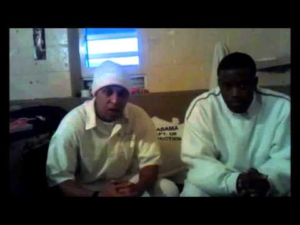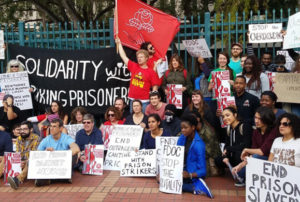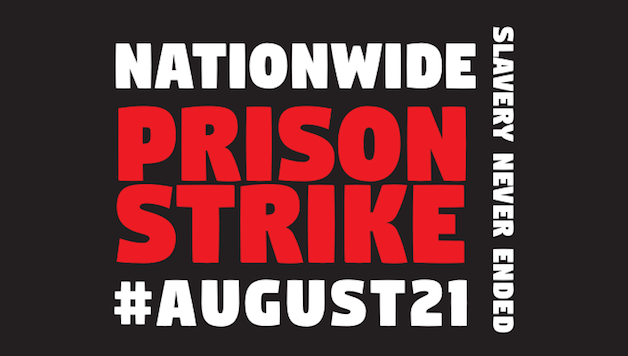Jack Willis and Luke Eckenrod
“Prison is a second-by-second assault on the soul, a day-to-day degradation of the self, an oppressive steel and brick umbrella that transforms seconds into hours and hours into days.”
Mumia Abu-Jamal, political prisoner, journalist, and former Black Panther Party member.
Last Tuesday, on August 21, 2018, prisoners across the U.S. began the largest prison strike in the country’s history. The strikers are demanding an end to prison slavery and for “immediate improvements to the conditions of prisons and prison policies that recognize the humanity of imprisoned men and women.” The strike — which consists of work stoppages, sit-ins, prison store boycotts, and hunger strikes — is expected to last until September 9.
Prisons in every state use cheap incarcerated labor. Most states pay these workers mere cents per hour, while some pay nothing at all. Prisoners are coerced to work under these conditions. For example, all able federal prisoners must work for the government-owned Federal Prison Industries, Inc., which trades under the name UNICOR.
The government’s legal right to use prison slavery was established after the Civil War. The 13th Amendment, adopted in 1865, prohibits “slavery [and] involuntary servitude, except as a punishment for crime.” Prisoners are demanding an end to coerced labor and for incarcerated workers to be paid the prevailing wage in their area.
The strikers are also targeting many other policies of the U.S. prison and criminal-legal systems which contribute to racist mass incarceration. They demand an end to racist overcharging by courts and racist targeting by law enforcement. In particular, they demand the repeal of the Sentencing Reform Act and “truth-in-sentencing” laws, which limit parole. They argue that no human should be sentenced to life in prison or serve any sentence without possibility of parole. They point to “gang sentencing enhancement” laws, which are applied at the discretion of the court and which lengthen sentences for those with “gang ties.” They demand the vote for prisoners and those with felony convictions; and better penal-system grievance processes, which were reformed in the 1990s to decrease prisoners’ ability to file lawsuits. In addition, they demand the reinstitution of Pell Grants for prisoners and guaranteed access to improved rehabilitation services, including mental health care.

The prison labor movement has been growing in strength, with over a dozen strikes being reported over the past few years. In 2016, a national prison strike on the 45th anniversary of the Attica prison uprising involved 24,000 prisoners. In 2017, the Millions for Prisoners Human Rights March took place in D.C. and at least 16 other cities. The march caused prison administrators in Florida and South Carolina to lock down their entire state systems, with a population of 121,000, just to prevent any show of solidarity on the inside.
In 2018, local prisoner actions were reported in at least Louisiana, Florida, Texas, Missouri, and Ohio. This year’s national strike was pledged to take place in 17 states, and has already been confirmed in 10 states. When reports on strike action fully emerge, organizers expect it to be the largest prison strike in U.S. history.
The strike involves members of the collective Jailhouse Lawyers Speak (JLS), which released the strike notice; the prisoner rights group, Free Alabama Movement (FAM), whose tactics the strike is inspired by; and the Incarcerated Workers Organizing Committee (IWOC), a section of the Industrial Workers of the World (IWW); among others. At the time this was written, 272 groups had endorsed the strike.
Incarcerated Workers Get Organized
Incarcerated organizers called the strike in response to tragic violence which took place inside Lee Correctional Institution, a maximum-security prison in South Carolina. On April 15, prison guards watched a fight escalate within one of Lee’s housing units, then blocked the exit, leaving prisoners with no escape. Then, they turned their backs to the prisoners for hours. As a result, twenty-two prisoners were hospitalized and seven died of blood loss from stabbing. According to the prisoners’ April 24 strike notice, “Seven comrades lost their lives during a senseless uprising that could have been avoided had the prison not been so overcrowded from the greed wrought by mass incarceration, and a lack of respect for human life that is embedded in our nation’s penal ideology.”
The strike’s dates refer to the 1971 Attica Prison Uprising. On August 21 of that year, prison activist George Jackson, who became a Black Panther Field Marshal while incarcerated, was shot down under suspicious circumstances during what prison officials described an escape attempt. Two weeks after his murder, on September 9, the uprising at Attica broke out. The strikers’ decision to connect their struggle to the legacy of George Jackson and Attica is a reminder of the movement’s revolutionary potential.
The strike tactics are focused on unifying prisoners through non-violent action. Those in each prison have determined the length of their strike, its local tactics, as well as local demands. However, the overall strike consists of four main tactics. First, prisoners are refusing to report to assigned jobs. Second, those in certain prisons shall engage in peaceful sit-ins. Third, prisoners are encouraged to halt spending at prison stores. Fourth, prisoners are engaging in hunger strikes.

Organizing is difficult in the prison environment, which is characterized by domination, degradation, and surveillance. Prisoners don’t have the legal right to strike or collectively bargain, and those who participate in concerted action have little to no recourse against illegal retaliation. Hence, FAM have emphasized the importance of contraband cellphones as an organizing tool for prisoners, and as a tool to hold prison officials accountable through video recording.
IWOC have confirmed the strike in some areas and will continue to release updates as information comes out. These reports may emerge slowly as access to this information is actively limited by prisons. IWOC have reported that cellphone lines were possibly jammed in multiple prisons across South Carolina, and that New Mexico had a statewide lockdown on the 21st. Prison activist Malik Washington also reported on widespread repression in Texas prisons. IWOC maintains a list of individual prisoners facing political retaliation.
Political retaliation isn’t just the work of “rogue” prison officers; it’s a result of the entire prison-industrial complex and is completely ingrained in it. There are multiple factors which account for retaliation, for example: the “blue wall of silence” and the sadistic culture of the penal system, the overcrowding and bad conditions in prisons, and the prisons’ financial incentive to keep production going. Changing the penal system partially wouldn’t be enough to change its outcome, since the system’s components reinforce each other and guarantee a single result. The whole penal system must be completely replaced by a democratic restorative justice system.
Striking shows bravery on the part of prisoners. They are fighting to improve the conditions of themselves and other prisoners using the only method they can, by putting their bodies on the line. As with any strike, management hopes for a disconnect between the workplace struggle and the broader community. The role which outside organizations and activists can play is to build support with those most affected by racist mass incarceration. Working with the families and neighbors of those imprisoned to show clear solidarity with the prisoners’ struggle can help deprive government officials of the opportunity to use disingenuous and divisive tactics to demoralize and further repress striking prisoners. These shows of solidarity will be essential to the success of prison strikes. Organizing efforts can even raise their own demands for fundamentally changing the living conditions which drive survival behaviors that are criminalized by the state.
Who Benefits From Prison Slavery?
The U.S. prison system “costs” the government approximately $80 billion per year. This figure is misleading since this cost includes guaranteed access to prisoners’ ability to work. While the plurality of incarcerated workers have non-industrial prison upkeep jobs, many produce necessary goods directly for state agencies, or commodities which are sold by corporations and the state. In fact, the U.S. federal government publicly sells goods produced by prison labor in violation of international standards.
As the government sees prisons as an economic opportunity, so does the private sector. Since the “war on drugs” began in the 1980s, corrections departments have increasingly relied on private prisons to incarcerate their record numbers of prisoners. Privately-owned prisons now represent 8.5% of the total U.S. prison population. This segment grew by 47% between 2000 and 2016. During the same period of time, the privately-run immigrant detention population grew by over 400%, owing to the shift in U.S. immigration policy.
The rise of privately-owned prisons coincides with to a race to the bottom for prison conditions, as contractors compete to provide the lowest bid for any given service. These worsening conditions inevitably lead to unrest and against it, repression. Private prisons, seeking to increase the prison population, frequently donate to “tough-on-crime” politicians. This motive was laid bare in a 2011 case where a Pennsylvania juvenile court judge admitted to receiving kickbacks from a privately-owned youth prison. The interest of “corrections industry” contractors and private prison operators is to maintain the system of racist mass incarceration. They use their economic weight to put pressure on the political system and keep incarceration rates high.
All prisons operate captive markets to extract all the money they can from prisoners and their families. Prisoners typically make about $60 gross per month, and lose over half to withholding. However, they must pay for incidentals like payphone calls, medical co-pays, writing materials, shampoo, haircuts, snacks, clothing, laundry; as well as fees for debit card transactions, drug testing, transportation, booking, and court processing.

Corrections departments say prison slavery is a “job opportunity.” They say it gives prisoners skills, life purpose, and that it lowers recidivism. These rationales are not good enough, given that the work is forced, extremely exploitative and often hazardous, and how much prison takes away from a person in general. The argument that prison slavery lowers recidivism is especially absurd since time and money spent on work programs replaces education and rehabilitation! Even according to their own brochures, federal work program UNICOR “saves taxpayers” $8,000 to $9,000 per year per prisoner by replacing “alternative programming.”
Most of those incarcerated in the U.S. are in state prisons and therefore most productive prison labor benefits state governments. Take Wisconsin’s Badger State Industries as an example, which uses prison labor to manufacture products for state and local government agencies, including chairs and tables used in state universities.
Prison labor is notably used to offset the effects of climate change. The State of California recently bragged about paying prisoners, including youth offenders, $2 gross per day to fight the largest wildfires in state history. Dane County, Wisconsin is using prison labor to fill sandbags during the current flooding. The cost of climate-linked disasters are not paid by real estate developers and capitalist industry meanwhile environmental regulations are being eroded at the state and federal levels. Ecological costs are pushed off to the rest of society, especially the most oppressed. Ironically, the capitalist system which created the ecological mess is the same that systematically deprives the incarcerated, who are disproportionately poor and people of color, of opportunities to avoid crimes of poverty.
Prison labor is essential to state economies. When prisoners use their power to shut down this cash flow, they yield concessions. These same strikes have also garnered publicity and advanced the public discourse on prison slavery and prisoner rights.
Nothing to Lose but Our Chains
Socialist Alternative endorses the 2018 prison strike. The struggle for prisoners’ rights and the need to end racist mass incarceration must be a central demand for the movement to end class and racial oppression. As the prison labor movement grows, there is a great need for prisoners and the broader labor movement to link up. The ability of prisoners to defend themselves against retaliation will be crucial to the strength of the movement. As we mentioned before, a crucial component to these struggles is awareness. Prison and government officials are keen to keep the reality of imprisonment from the public. Activists and organizations seeking to assist in this struggle should organize with families and communities most impacted. Nevertheless, prison and government officials will seek to suppress these struggles, by violence if necessary. They often relocate leading organizers and/or punish them with solitary confinement. Prison guards are tasked with carrying out these methods of suppression.
Socialist Alternative calls on prison guards to strike in solidarity with prisoners, as some did during the 2016 strike in defiance of prison administration. Prison guards are often faced with unsafe conditions, though it is in response to the brutality they are tasked to carry out against prisoners. Individually refusing to do so would result in punishment or firing. However, both groups would benefit from better conditions for prisoners. While government and prison officials demand this brutality, they neither carry it out personally nor face the consequences of despairing prisoners lashing out. Prison guards, as workers within the prisons, can use this as an opportunity to demand better conditions for prisoners and themselves. They can refuse to carry out acts of repression or punishment. As a unified group, both prisoners and prison guards should demand a complete restructuring of the incarceration system.
Permanent, successful re-entry of those incarcerated back into society should be a main concern for a criminal justice system. This would require restructuring our current system toward one based on restorative justice. Instead of further alienating prisoners from society, which only fosters anti-social behavior, prisoners need access to education, therapy and community.
Leaving the prisons, there are many systematic methods of excluding prisoners from successfully re-entering society. This plays out in state laws that prohibit prisoners and felons from voting, prohibit felons’ entry into public and affordable housing, and allow questions about felony convictions on job applications. We demand the right to vote for prisoners and ex-prisoners, to help change the policies which contributed to their incarceration. We demand access to public services and public supportive housing to assist ex-prisoners in their transition back into society, to raze any barriers to effective re-entry, thereby reducing recidivism. We should also demand that all states and the federal government “ban the box” on job applications which allow employers to discriminate based on criminal record — an explicitly racist function.
While we are attacking the system head-on, we must also undercut the conditions which allow it to thrive. Exclusion of Black working-class and poor Americans from the economy, and thereby broader society, goes even further. The crises of capitalism fall especially hard on those facing double and triple oppression. There is a natural link between the end of racist mass incarceration and the fight against poverty and for demands like Medicare for All, a $15 an hour minimum wage, free college tuition, funding for public education, and public affordable housing. The prison-industrial complex thrives off of the criminalization of poverty, thus a fight for better living standards is a fight against racism, sexism, xenophobia, and anti-LGBTQ oppression.

In states like California where prison labor is used to replace otherwise highly-paid union jobs, the prison-industrial complex serves as impetus to keep workers and unions from having a larger slice of the economy. For public employers, it is an excuse to cut taxes for the rich and for private employers to keep living-wage job numbers low. In this way, the fight for protecting labor rights, which are under constant attack, is also directly connected to the fight to end prison slave labor.
As U.S. capitalism has developed unevenly and gone through changes over time, so has the penal system which is tied to its core. Challenging today’s prison system means challenging capitalism which puts profits before people and communities and which has led to the current situation. The movement for prisoners’ rights is therefore tied to that of workers’ rights in the fight for a socialist future — one where we can envision and end to prisons.
There is a path for less-oppressed groups to link up with their more-oppressed siblings in our common struggle. In the end, to bring an end to racism and other forms of identity oppression as well as the exploitation of workers by a handful who control most of the wealth, we must fight for an end to the capitalist system. To quote Leon Trotsky, a leading figure of the Russian Revolution: “We send our warmest greetings to our imprisoned and persecuted comrades and tell them not to lose heart. From the capitalist prisons and concentration camps will come most of the leaders of tomorrow’s world!”
Supporting the Strikers
The strikers are asking for supporters to:
- Make the nation take a look at our demands. Demand action on our demands by contacting your local, state, and federal political representatives with these demands. Ask them where they stand.
- Spread the strike and word of the strike in every place of detention.
- Contact a supporting local organization to see how you can be supportive. If you are unsure of who to connect with, email [email protected]
- Be prepared by making contact with people in prison, family members of prisoners, and prisoner support organizations in your state to assist in notifying the public and media on strike conditions.
- Assist in our announced initiatives to have the votes of people in jail and prison counted in elections.
- Donate to the strike’s official fundraising page.
Other strike resources:
- News index and local events: https://itsgoingdown.org/prisonstrike/
- Social media accounts: @JailLawSpeak @IWW_IWOC facebook.com/BlkJailhouseLawyer
- Newsletter: http://sawarimi.org/npsnewsletter
- Resource index: http://prisonstrike.com/
- Support pamphlet: https://iwocoakland.wordpress.com/2018/06/07/national-prison-strike-support-pamphlet/


